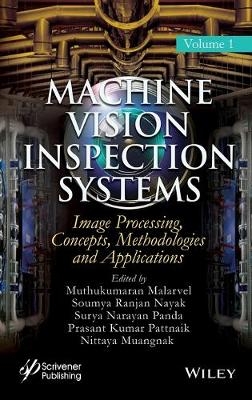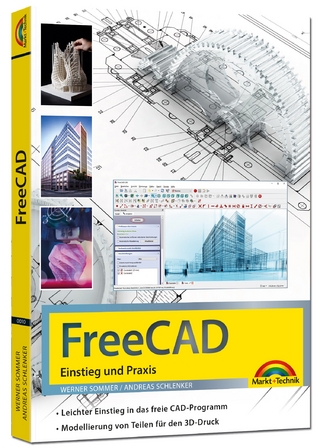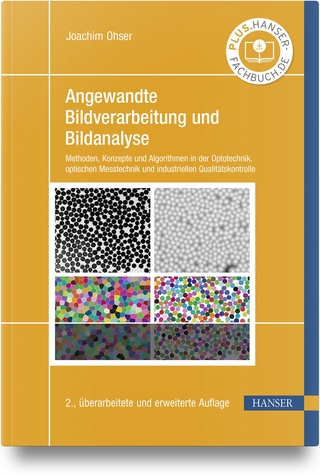
Machine Vision Inspection Systems, Image Processing, Concepts, Methodologies, and Applications
Wiley-Scrivener (Verlag)
978-1-119-68180-9 (ISBN)
Machine vision inspection systems (MVIS) utilized all industrial and non-industrial applications where the execution of their utilities based on the acquisition and processing of images. MVIS can be applicable in industry, governmental, defense, aerospace, remote sensing, medical, and academic/education applications but constraints are different. MVIS entails acceptable accuracy, high reliability, high robustness, and low cost. Image processing is a well-defined transformation between human vision and image digitization, and their techniques are the foremost way to experiment in the MVIS. The digital image technique furnishes improved pictorial information by processing the image data through machine vision perception. Digital image processing has widely been used in MVIS applications and it can be employed to a wide diversity of problems particularly in Non-Destructive testing (NDT), presence/absence detection, defect/fault detection (weld, textile, tiles, wood, etc.,), automated vision test & measurement, pattern matching, optical character recognition & verification (OCR/OCV), barcode reading and traceability, medical diagnosis, weather forecasting, face recognition, defence and space research, etc. This edited book is designed to address various aspects of recent methodologies, concepts and research plan out to the readers for giving more depth insights for perusing research on machine vision using image processing techniques.
Muthukumaran Malarvel obtained his PhD in Digital Image Processing and he is currently working as an Associate Professor in the Department of Computer Science and Engineering at Chitkara University, Punjab, India. His research interests include digital image processing, machine vision systems, image statistical analysis & feature extraction, and machine learning algorithms. Soumya Ranjan Nayak obtained his PhD in computer science and engineering from the Biju Patnaik University of Technology, India. He has more than a decade of teaching and research experience and currently is working as an Assistant Professor, Amity University, Noida, India. His research interests include image analysis on fractal geometry, color and texture analysis jointly and separately. Surya Narayan Panda is a Professor and Director Research at Chitkara University, Punjab, India. His areas of interest include Cybersecurity, Networking, Advanced Computer Networks, Machine Learning, and Artificial Intelligence. He has developed the prototype of Smart Portable Intensive Care Unit through which the doctor can provide immediate virtual medical assistance to emergency cases in the ambulance. He is currently involved in designing different healthcare devices for real-time issues using AI and ML. Prasant Kumar Pattnaik Ph.D. (Computer Science), Fellow IETE, Senior Member IEEE is a Professor at the School of Computer Engineering, KIIT Deemed to be University, Bhubaneswar, India. He has more than a decade of teaching and research experience. His areas of interest include Mobile Computing, Cloud Computing, Cyber Security, Intelligent Systems and Brain Computer Interface. Nittaya Muangnak is a lecturer at Kasetsart University, Thailand. Her PhD research has been on medical image analysis, particularly retinal fundus image, at Sirindhorn International Institute of Technology, Thammasat University in Thailand.
Preface xi
1 Land-Use Classification with Integrated Data 1
D. A. Meedeniya, J. A. A. M Jayanetti, M. D. N. Dilini, M. H. Wickramapala and J. H. Madushanka
1.1 Introduction 2
1.2 Background Study 3
1.2.1 Overview of Land-Use and Land-Cover Information 3
1.2.2 Geographical Information Systems 4
1.2.3 GIS-Related Data Types 4
1.2.3.1 Point Data Sets 4
1.2.3.2 Aerial Data Sets 5
1.2.4 Related Studies 6
1.3 System Design 6
1.4 Implementation Details 10
1.4.1 Materials 10
1.4.2 Preprocessing 11
1.4.3 Built-Up Area Extraction 11
1.4.4 Per-Pixel Classification 12
1.4.5 Clustering 14
1.4.6 Segmentation 14
1.4.7 Object-Based Image Classification 16
1.4.8 Foursquare Data Preprocessing and Quality Analysis 20
1.4.9 Integration of Satellite Images with Foursquare Data 21
1.4.10 Building Block Identification 21
1.4.11 Overlay of Foursquare Points 22
1.4.12 Visualization of Land Usage 23
1.4.13 Common Platform Development 23
1.5 System Evaluation 25
1.5.1 Experimental Evaluation Process 25
1.5.2 Evaluation of the Classification Using Base Error Matrix 28
1.6 Discussion 31
1.6.1 Contribution of the Proposed Approach 31
1.6.2 Limitations of the Data Sets 32
1.6.3 Future Research Directions 33
1.7 Conclusion 34
References 35
2 Indian Sign Language Recognition Using Soft Computing Techniques 37
Ashok Kumar Sahoo, Pradeepta Kumar Sarangi and Parul Goyal
2.1 Introduction 37
2.2 Related Works 38
2.2.1 The Domain of Sign Language 39
2.2.2 The Data Acquisition Methods 41
2.2.3 Preprocessing Steps 42
2.2.3.1 Image Restructuring 43
2.2.3.2 Skin Color Detection 43
2.2.4 Methods of Feature Extraction Used in the Experiments 44
2.2.5 Classification Techniques 45
2.2.5.1 K-Nearest Neighbor 45
2.2.5.2 Neural Network Classifier 45
2.2.5.3 Naive Baÿes Classifier 46
2.3 Experiments 46
2.3.1 Experiments on ISL Digits 46
2.3.1.1 Results and Discussions on the First Experiment 47
2.3.1.2 Results and Discussions on Second Experiment 49
2.3.2 Experiments on ISL Alphabets 51
2.3.2.1 Experiments with Single-Handed Alphabet Signs 51
2.3.2.2 Results of Single-Handed Alphabet Signs 52
2.3.2.3 Experiments with Double-Handed Alphabet Signs 53
2.3.2.4 Results on Double-Handed Alphabets 54
2.3.3 Experiments on ISL Words 58
2.3.3.1 Results on ISL Word Signs 59
2.4 Summary 63
References 63
3 Stored Grain Pest Identification Using an Unmanned Aerial Vehicle (UAV)-Assisted Pest Detection Model 67
Kalyan Kumar Jena, Sasmita Mishra, Sarojananda Mishra and Sourav Kumar Bhoi
3.1 Introduction 68
3.2 Related Work 69
3.3 Proposed Model 70
3.4 Results and Discussion 72
3.5 Conclusion 77
References 78
4 Object Descriptor for Machine Vision 85
Aparna S. Murthy and Salah Rabba
4.1 Outline 85
4.2 Chain Codes 87
4.3 Polygonal Approximation 89
4.4 Moments 92
4.5 HU Invariant Moments 96
4.6 Zernike Moments 97
4.7 Fourier Descriptors 98
4.8 Quadtree 99
4.9 Conclusion 102
References 114
5 Flood Disaster Management: Risks, Technologies, and Future Directions 115
Hafiz Suliman Munawar
5.1 Flood Management 115
5.1.1 Introduction 115
5.1.2 Global Flood Risks and Incidents 116
5.1.3 Causes of Floods 118
5.1.4 Floods in Pakistan 119
5.1.5 Floods in Australia 121
5.1.6 Why Floods are a Major Concern 123
5.2 Existing Disaster Management Systems 124
5.2.1 Introduction 124
5.2.2 Disaster Management Systems Used Around the World 124
5.2.2.1 Disaster Management Model 125
5.2.2.2 Disaster Risk Analysis System 126
5.2.2.3 Geographic Information System 126
5.2.2.4 Web GIS 126
5.2.2.5 Remote Sensing 127
5.2.2.6 Satellite Imaging 127
5.2.2.7 Global Positioning System for Imaging 128
5.2.3 Gaps in Current Disaster Management Technology 128
5.3 Advancements in Disaster Management Technologies 129
5.3.1 Introduction 129
5.3.2 AI and Machine Learning for Disaster Management 130
5.3.2.1 AIDR 130
5.3.2.2 Warning Systems 130
5.3.2.3 QCRI 131
5.3.2.4 The Concern 131
5.3.2.5 BlueLine Grid 131
5.3.2.6 Google Maps 132
5.3.2.7 RADARSAT-1 132
5.3.3 Recent Research in Disaster Management 132
5.3.4 Conclusion 137
5.4 Proposed System 137
5.4.1 Image Acquisition Through UAV 138
5.4.2 Preprocessing 138
5.4.3 Landmarks Detection 138
5.4.3.1 Buildings 139
5.4.3.2 Roads 139
5.4.4 Flood Detection 140
5.4.4.1 Feature Matching 140
5.4.4.2 Flood Detection Using Machine Learning 141
5.4.5 Conclusion 143
References 143
6 Temporal Color Analysis of Avocado Dip for Quality Control 147
Homero V. Rios-Figueroa, Micloth López del Castillo-Lozano, Elvia K. Ramirez-Gomez and Ericka J. Rechy-Ramirez
6.1 Introduction 147
6.2 Materials and Methods 148
6.3 Image Acquisition 149
6.4 Image Processing 150
6.5 Experimental Design 150
6.5.1 First Experimental Design 150
6.5.2 Second Experimental Design 151
6.6 Results and Discussion 151
6.6.1 First Experimental Design (RGB Color Space) 151
6.6.2 Second Experimental Design (L*a*b* Color Space) 152
6.7 Conclusion 156
References 156
7 Image and Video Processing for Defect Detection in Key Infrastructure 159
Hafiz Suliman Munawar
7.1 Introduction 160
7.2 Reasons for Defective Roads and Bridges 161
7.3 Image Processing for Defect Detection 162
7.3.1 Feature Extraction 162
7.3.2 Morphological Operators 163
7.3.3 Cracks Detection 164
7.3.4 Potholes Detection 165
7.3.5 Water Puddles Detection 166
7.3.6 Pavement Distress Detection 167
7.4 Image-Based Defect Detection Methods 169
7.4.1 Thresholding Techniques 170
7.4.2 Edge Detection Techniques 170
7.4.3 Wavelet Transform Techniques 171
7.4.4 Texture Analysis Techniques 171
7.4.5 Machine Learning Techniques 172
7.5 Factors Affecting the Performance 172
7.5.1 Lighting Variations 173
7.5.2 Small Database 173
7.5.3 Low-Quality Data 173
7.6 Achievements and Issues 173
7.6.1 Achievements 174
7.6.2 Issues 174
7.7 Conclusion 174
References 175
8 Methodology for the Detection of Asymptomatic Diabetic Retinopathy 179
Jaskirat Kaur and Deepti Mittal
8.1 Introduction 180
8.2 Key Steps of Computer-Aided Diagnostic Methods 181
8.3 DR Screening and Grading Methods 183
8.4 Key Observations from Literature Review 188
8.5 Design of Experimental Methodology 189
8.6 Conclusion 192
References 193
9 Offline Handwritten Numeral Recognition Using Convolution Neural Network 197
Abhisek Sethy, Prashanta Kumar Patra and Soumya Ranjan Nayak
9.1 Introduction 198
9.2 Related Work Done 199
9.3 Data Set Used for Simulation 201
9.4 Proposed Model 202
9.5 Result Analysis 204
9.6 Conclusion and Future Work 207
References 209
10 A Review on Phishing—Machine Vision and Learning Approaches 213
Hemamalini Siranjeevi, Swaminathan Venkatraman and Kannan Krithivasan
10.1 Introduction 213
10.2 Literature Survey 214
10.2.1 Content-Based Approaches 214
10.2.2 Heuristics-Based Approaches 215
10.2.3 Blacklist-Based Approaches 215
10.2.4 Whitelist-Based Approaches 216
10.2.5 CANTINA-Based Approaches 216
10.2.6 Image-Based Approaches 216
10.3 Role of Data Mining in Antiphishing 217
10.3.1 Phishing Detection 219
10.3.2 Phishing Prevention 220
10.3.3 Training and Education 222
10.3.4 Phishing Recovery and Avoidance 222
10.3.5 Visual Methods 223
10.4 Conclusion 224
Acknowledgments 224
References 224
Index 231
| Erscheinungsdatum | 31.12.2019 |
|---|---|
| Reihe/Serie | Machine Vision Inspection Systems |
| Sprache | englisch |
| Maße | 10 x 10 mm |
| Gewicht | 454 g |
| Themenwelt | Informatik ► Grafik / Design ► Digitale Bildverarbeitung |
| Informatik ► Theorie / Studium ► Künstliche Intelligenz / Robotik | |
| Technik ► Elektrotechnik / Energietechnik | |
| ISBN-10 | 1-119-68180-4 / 1119681804 |
| ISBN-13 | 978-1-119-68180-9 / 9781119681809 |
| Zustand | Neuware |
| Informationen gemäß Produktsicherheitsverordnung (GPSR) | |
| Haben Sie eine Frage zum Produkt? |
aus dem Bereich


